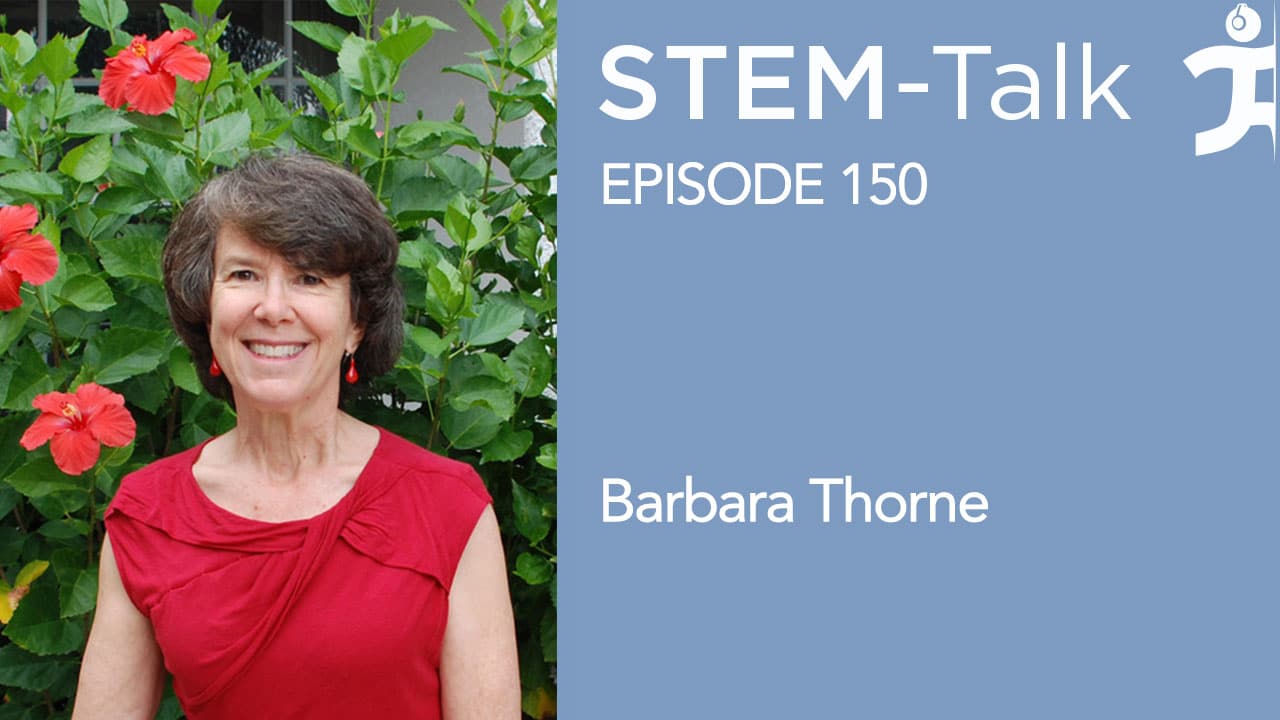STEM-Talk
Episode 150: Barbara Thorne talks about E.O. Wilson, the conehead termite and the sociality of termites
// Mar 21, 2023

Today we have Dr. Barbara Thorne, a termite biologist and an expert on the invasive conehead species, a Central and South American termite that has invaded South Florida.
Barbara is a research professor and professor emerita in the Department of Entomology at the University of Maryland. Since 2012 she has served as the Florida Department of Agriculture and Consumer Services science advisor on the state’s Conehead Termite Program. She also chairs the National Scientific Advisory Committee for the Conehead Termite Program.
Barbara’s research focuses on the biology of termites, which are highly social insects that form complex colony structures. She earned her Ph.D. in Organismic and Evolutionary Biology in 1983 from Harvard University where she studied with the late Dr. E. O. Wilson, a renowned biologist and naturalist.
Show notes
[00:03:14] Dawn points out that Barbara is from Southern California and asks Barbara if she were a Valley Girl since she grew up in the San Fernando Valley. [00:03:42] Dawn mentions that it was wanderlust that sent Barbara from the West Coast to the East Coast for college and asks why she decided on Brown University. [00:04:14] After Barbara explains that she was originally not interested in science, Ken asks what changed her mind. [00:06:34] Dawn mentions that some kids grow up fascinated with bugs, but not Barbara, so Dawn asks what eventually triggered Barbara’s academic interest in insects. [00:07:58] Ken asks Barbara to elaborate on how Bug Camp and E.O. Wilson’s book “The Insect Societies” motivated her to go to Harvard. [00:10:22] Dawn explains, for those who aren’t familiar, that E.O. Wilson was an American biologist who was recognized as the world’s leading authority on ants among other topics. He spent 40 years on the Harvard faculty and authored more than 30 books, including two that won Pulitzer Prizes. Dawn asks how Wilson became Barbara’s Ph.D. faculty advisor. [00:14:15] Ken asks why Barbara often refers to the time she was at Harvard as the golden age for research into social insects. [00:18:31] Dawn asks about Barbara’s initial goal for her Ph.D. dissertation, which was to investigate the evolutionary driver that created the sociality in termites, who are a completely different branch of insects from the classic social insects (ants, bees, and wasps). Dawn goes on to ask what Wilson thought of this idea when Barbara proposed it. [00:21:22] Barbara spent 15 years in E.O. Wilson’s lab and Ken wonders if she has a favorite story about Wilson. [00:28:29] Dawn explains that for Barbara’s postdoc research, she continued to expand on the work of her dissertation, and then began working in the field of applied termite biology and targeted applications for control. This was when chlordane, a powerful pesticide against termites, was pulled from the market. Dawn asks Barbara to talk about the significance of pulling chlordane from the market and how this created an opportunity for her. [00:31:30] Ken asks Barbara what led her to join the faculty at the University of Maryland in the early 1990s. [00:33:59] Dawn mentions that during Barbara’s time at Maryland, she investigated her hypothesis of accelerated inheritance as a driver for the evolution of eusociality in termites, following up this research in a 2003 paper in PNAS. Dawn goes on to explain that the paper provided experimental evidence for the powerful selective forces driving the evolution of eusociality in termites, a question that perplexed Charles Darwin. Dawn asks Barbara to talk about why Darwin was confused by the existence of social insects and how Barbara approached this question in termites. [00:49:16] Dawn mentions that Barbara expanded on the previously mentioned research with a study in 2009, using genetic markers to demonstrate that in merged colonies, offspring from both original, unrelated families can become new reproductives and even interbreed. Dawn asks Barbara to explain why this observation is important. [00:50:33] Ken explains that Barbara helped put together a TED-Ed video lesson last year that depicted a conehead termite queen as she begins her reign as one of the longest living insects in the animal kingdom. Ken goes on to mention that this video was a collaboration with Thomas Johnson Volda, and Ken asks how the idea for the video came to be. [00:53:20] Dawn explains that since September of 2012, Barbara has served as the science advisor for the Florida Department of Agriculture and Consumer Services, and is helping the state target the invasive conehead termite. Dawn goes on to mention that this species was the focus of Barbara’s Ph.D. dissertation research in Central America. Dawn asks how Barbara was approached to aid in handling this species invasion into Florida. [00:55:11] Dawn mentions that conehead termites have expansive tastes, which makes them a serious problem in Florida, and asks Barbara to give a sense of the damage that the conehead termites are causing. [01:01:34] Ken mentions the similarities between the current situation with conehead termites and the Formosan termite invasion into North America. [01:05:38] Ken explains that in Pensacola, the home of IHMC, the historical district has many homes built in the 1800s and early 1900s that are made from very strong, dense, old-school wood, the kind of wood that is harder for termites to get into. Ken goes on to ask if it is true that Barbara has described the cheap, fast-growing wood used in today’s structures as a kind of candy for termites. [01:09:14] Ken mentions that we recently had Barbara’s husband Dr. Ed Weiler on STEM-Talk, episode 148. Ken goes on to mention that Ed and Barbara listened to the interview together and Ken asks what she thought of Ed’s episode. [01:13:11] Dawn closes the interview asking Barbara what she and Ed get up to now that they’re both retired.Links:
Reign of the Termite Queen video






